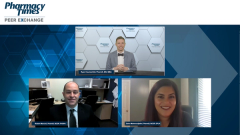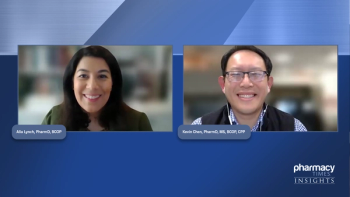
Risk Factors for Developing MDS
Medical experts provide an overview on potential risk factors leading to MDS.
Episodes in this series

Ryan Haumschild, PharmD, MS, MBA: I’d like to take it back to how we classify patients. Dr Mancini did a great job earlier of talking us through how you classify the different subtypes. We do know about the WHO [World Health Organization] classification system, but how does that compare to the FAB [French/American/British] classification systems, and how has that impacted diagnosing myelodysplastic syndrome? Are there differences? Are there unique considerations that we should be aware of?
Robert Mancini, PharmD, BCOP, FHOPA: As I mentioned earlier, the FAB system is a little narrower in their definitions and there are some overlap now with the newer classification diagnostic schemes related to AML [acute myeloid leukemia] and CMML [chronic myelomonocytic leukemia]. In both situations, those ring sideroblasts that I mentioned are part of the diagnosis, but the percentage of blasts and the separation include more genetic components, such as that deletion 5q. These have become key impacts on how we treat those patients. In the end, the ultimate benefit of this new system is more of an ability to differentiate MDS from other diseases. To Dr Mahmoudjafari’s point, MDS is really a proliferation of abnormal cells which leads to dysfunction. That helps us define the difference between other diseases. There’s lots of things going on and, eventually, MDS could potentially develop into AML, but for the most part, these patients are having issues related to that lack of normal function. For example, with the increased risk of infection, bleed risks, and anemia depending on which cell lines are affected. For the most part, patients who develop MDS are more likely to die from these other complications, especially cardiovascular complications, rather than a malignancy like leukemia itself. However, in more severe cases, it should be noted that the only cure for MDS is stem cell transplant. As we look at these patients in defining the difference, I think that’s where that new classification scheme really helps us separate it out from other hematologic malignancies.
Ryan Haumschild, PharmD, MS, MBA:Excellent. It’s so important to stratify patients appropriately and be aware of the risk factors that you talked about because they’re so impactful to these patients and their journey. Dr Mahmoudjafari, I’d like to pivot to you and talk about the risk factors for developing myelodysplastic syndrome. What are the molecular abnormalities or mutations that might be present that Dr Mancini spoke about, and when do you do your testing for these genetic mutations? Talk us through that care continuum of working up a patient, then obviously, how you address those risk factors?
Zahra Mahmoudjafari, PharmD, BCOP, DPLA: Just like Dr Mancini said, MDS results from changes in our bone marrow and the production of defective blood cells. There are several factors that can contribute to this change. The most frequent is previous treatment with chemotherapy. For instance, patients who received alkaline agents or topoisomerase II inhibitors. The risk for developing MDS after this type of treatment for them is higher 2 to 7 years after treatment, so we don’t see it right away. Patients who receive therapy are at risk for MDS, but independent of that, there are also environmental risk factors, including smoking, organic chemicals, heavy metals, and patients who have been exposed to herbicides, pesticides, and fertilizers throughout the course of their lifetime. Additionally, exhaust gases and other derivatives. It also has potentially a hereditary component, as well.
There are some patients who have a history of Diamond-Blackfan anemia, Fanconi anemia, and congenital neutropenia which cause them to be at risk for MDS. We’re learning more and more about these molecular abnormalities for all our hematological diseases, and MDS is certainly no exception to that. What we’ve learned is there’s a whole alphabet soup of mutations with the most frequently mutated gene cells. I always remember rTP53, SF3B1, RUNX1, JAK2, IDH1 and 2, although there is no single mutated gene that’s been found in more than [one-third] of patients. Several of these gene mutations that are associated with adverse clinical features also have complex karyotypes as seen with TP53. For example, excess bone marrow blast proportion, and severe thrombocytopenia. Again, we usually see those in patients with RUNX1, NRS, and TP53. We’re still learning more about the prognostic value of these mutations. I keep saying mutations for TP53 because we’ve seen that that can have a decreased overall survival in multivariant models that have been adjusted for IPSS [International Prognostic Scoring System]. There are other mutations like SF3B1 that can potentially be associated with a more favorable prognosis, even after that set adjustment. We’re learning that TET2 mutations have been shown to impact a response to hypomethylating agents, for instance, but I will say that the status of those molecular markers doesn’t preclude our use of these agents for therapy in our patients that we choose to treat.
Another very important mutation is deletion 5q that Dr Mancini mentioned earlier. Patients with deletion 5q, either as an isolated abnormality or often as part of a complex karyotype, have a higher rate of concomitant TP53 mutations, so therefore, they’re less responsive, or typically, relapse after treatment with lenalidomide. I will always remember deletion 5q and TP53, though. In terms of how often we test for genetic mutations, I would say it’s very important for us to know how the genes are mutated. We always use an initial evaluation to guide our diagnosis and our treatment decision, which helps us to determine the patient’s overall prognosis. We retest for genetic mutation after treatment as well to make sure that there are no other mutations that were not present at diagnosis, and this also helps us with further treatment, potentially with specific targets. This was a long-winded answer to that question.
Ryan Haumschild, PharmD, MS, MBA:It was a great answer because I think it’s good for our viewing audience to know that there are unique risk factors we need to screen for. A lot of these patients might be treatment-experienced with previous chemotherapy, or they might have some peripheral toxicities that are continuing to stay with them as we treat. We also recognize that [there are] a lot of mutations [we must be] screening for. How do we develop our precision medicine strategy to keep providing great therapeutics for these patients? I think that’s such an unmet need in current state that I think there’s hope for on the horizon.
Transcript edited for clarity.
Newsletter
Stay informed on drug updates, treatment guidelines, and pharmacy practice trends—subscribe to Pharmacy Times for weekly clinical insights.



